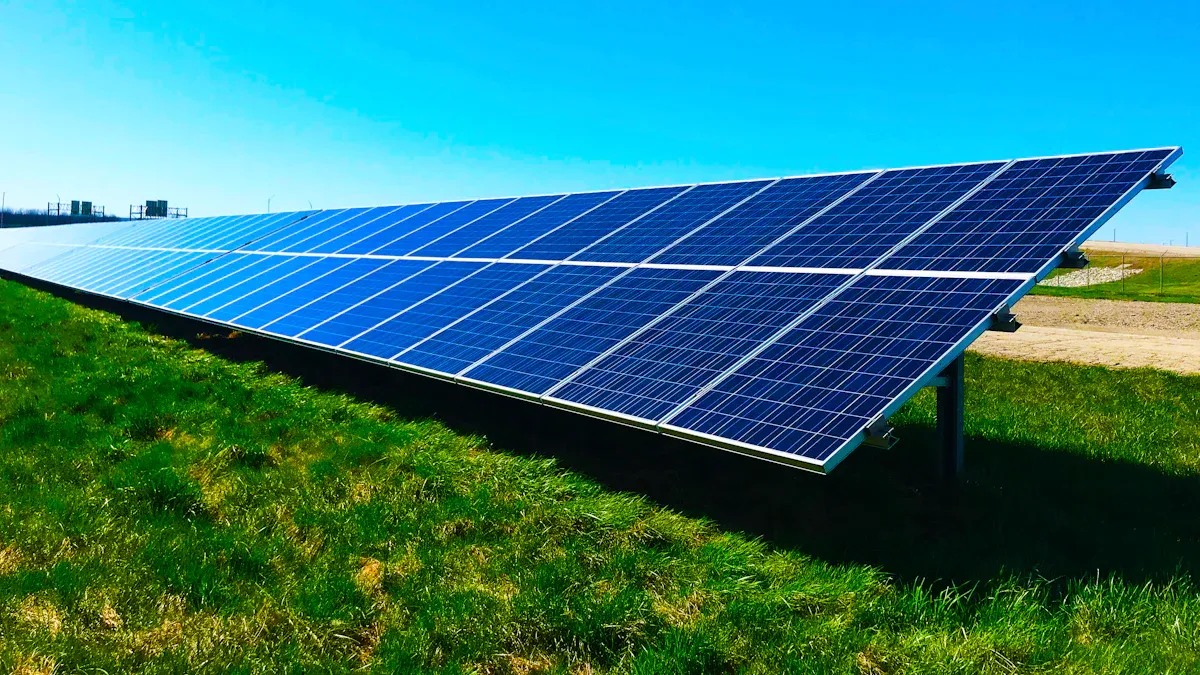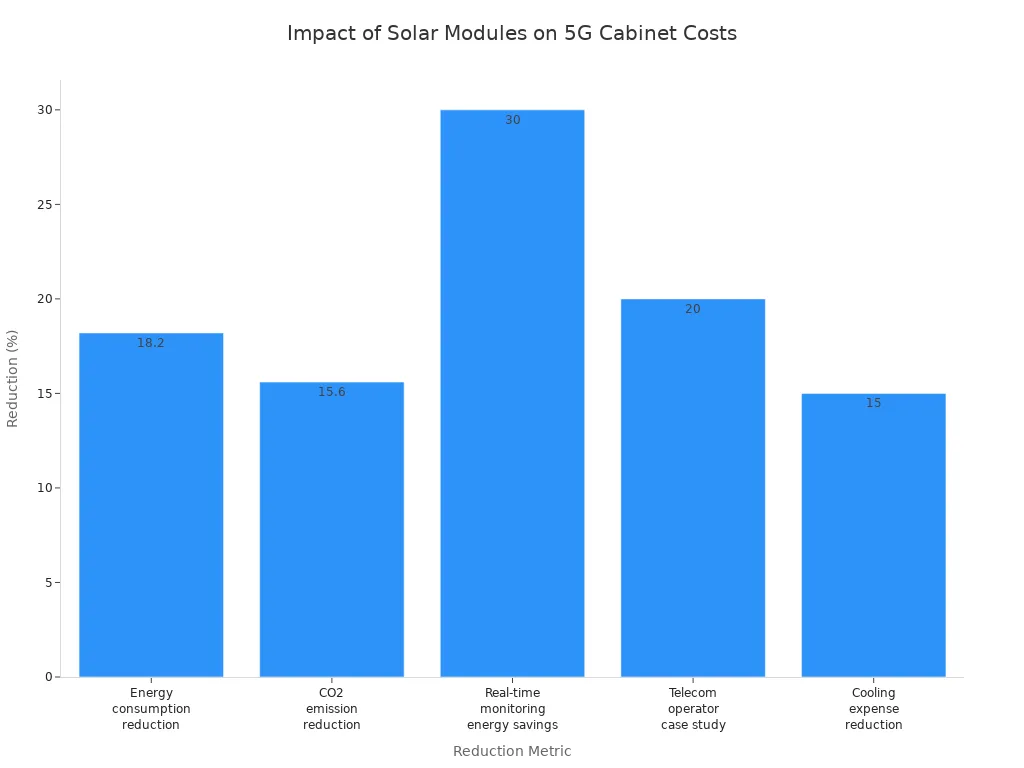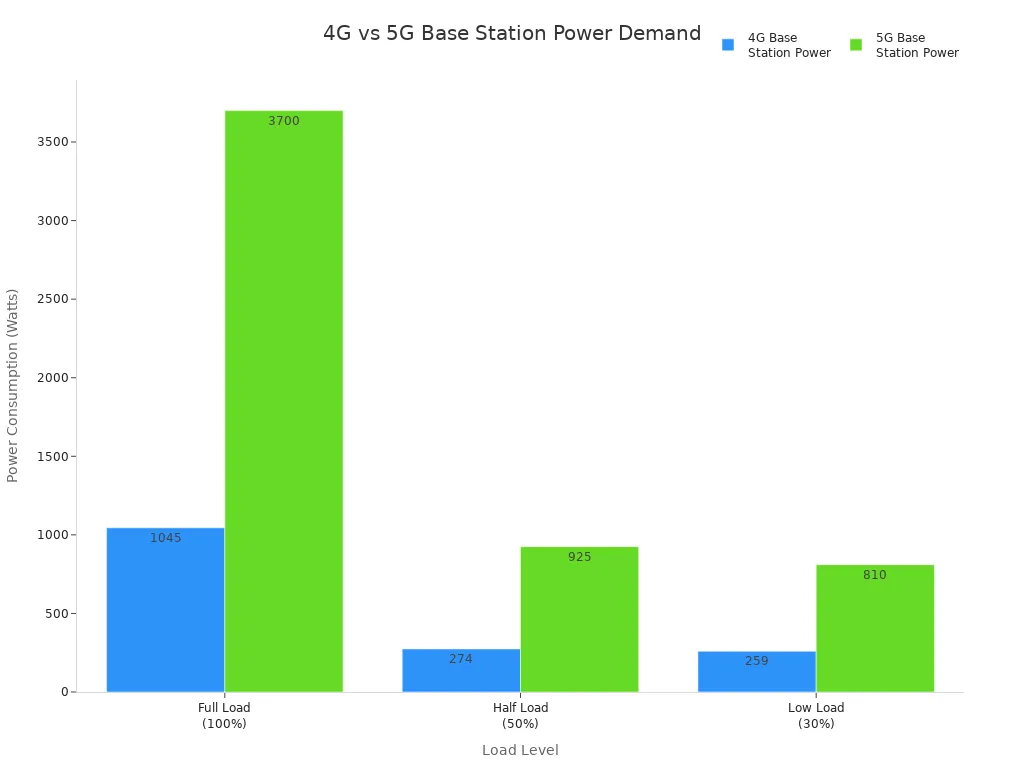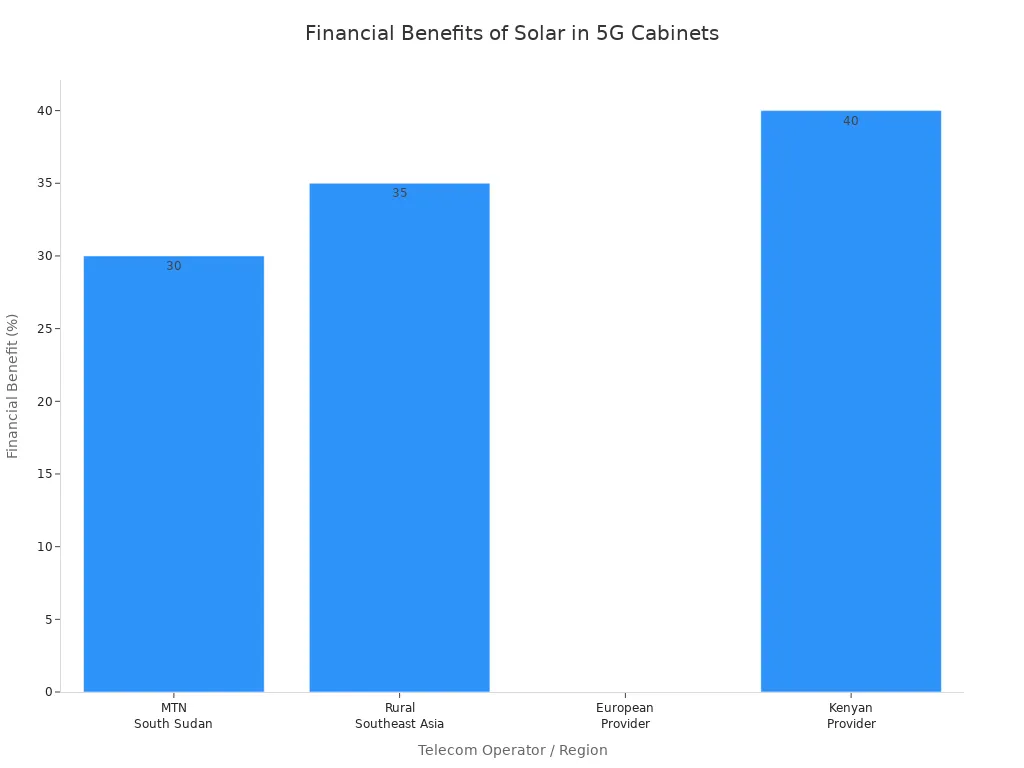reen Power Solutions for 5G Telecom Cabinets: How Solar Modules Cut Grid Electricity Costs by 30%

Solar Module integration enables 5G telecom cabinets to cut grid electricity costs by up to 30% through on-site renewable generation, hybrid energy management, and advanced storage. Operators experience lower operating expenses, less diesel use, and improved reliability. The following data highlights these savings:
Metric | Value |
|---|---|
Energy consumption reduction | 18.2% |
CO2 emission reduction | 15.6% |
Real-time monitoring energy savings | Up to 30% |
Telecom operator case study energy reduction | 20% |
Cooling expense reduction | 15% |

Key Takeaways
Solar modules help 5G telecom cabinets cut grid electricity costs by up to 30%, lowering operating expenses and reducing diesel fuel use.
Hybrid energy systems combine solar power, batteries, and grid or diesel backup to ensure reliable, continuous operation even in remote areas.
Battery storage supports energy management by storing excess solar power and providing backup during outages, improving network uptime.
Solar-powered telecom cabinets reduce carbon emissions and support sustainability goals by replacing diesel generators with clean energy.
Financial incentives like tax credits and grants make solar projects more affordable and encourage wider adoption in telecom networks.
Energy Challenges

5G Power Demand
5G telecom cabinets face a dramatic increase in power requirements compared to previous generations. The demand for higher data throughput, massive MIMO antenna arrays, and advanced cooling systems drives this surge. The following table highlights the difference in power consumption between 4G and 5G base stations:
Load Level | 4G Base Station Power (Watts) | 5G Base Station Power (Watts) | Power Increase Factor |
|---|---|---|---|
Full Load (100%) | ~1045 W | ~3700 W | |
Half Load (50%) | ~274 W | ~925 W | Significant increase |
Low Load (30%) | ~259 W | ~810 W | Significant increase |

Operators must deploy scalable and efficient rectifiers to stabilize power delivery. Modular cabinet designs allow for flexible power output, meeting the needs of expanding networks. Advanced monitoring tools enable remote management, reducing the need for site visits and improving reliability. In urban areas, compact DC power systems dominate due to their efficiency and space-saving features.
Grid Cost Impact
The increased energy demand from 5G cabinets places significant pressure on grid infrastructure and operational budgets. Key challenges include:
High operational costs due to greater electricity consumption.
Difficulty balancing high performance with energy efficiency, especially during fluctuating traffic periods.
The need for scalable and reliable power infrastructure to support large-scale 5G deployment.
Rapid adjustment requirements for power systems during sudden traffic spikes.
Regulatory compliance and the need for continuous upgrades, which add complexity and cost.
Environmental concerns driving the adoption of energy-efficient and sustainable solutions.
The necessity for advanced battery technologies and smart power management to reduce downtime and improve response times.
Off-grid and hybrid power solutions become essential in remote locations, reducing dependency on the grid and improving reliability.
Note: The integration of renewable energy sources, such as solar panels and advanced batteries, addresses many of these challenges by providing sustainable, reliable, and cost-effective power for 5G telecom cabinets.
Solar Module Integration

On-Site Generation
Solar Module installations on 5G telecom cabinets generate renewable electricity directly at the site. Photovoltaic panels convert sunlight into DC power, which supports telecom operations and reduces reliance on grid electricity and diesel generators. Operators select system sizes based on peak and average power consumption, local solar radiation, and required autonomy. Accurate sizing ensures the solar array and battery bank meet demand, even during periods of low sunlight. Hybrid inverters convert DC power to AC, manage battery charging, and maintain continuous power supply. Lithium Iron Phosphate batteries store excess energy, providing backup during outages and supporting uninterrupted network operation.
Huawei’s 5G Power solution demonstrates the effectiveness of Solar Module technology. Advanced maximum power point tracking (MPPT) increases electricity output by up to 30% compared to traditional systems. Annual energy savings reach approximately 4,130 kWh per site, highlighting the substantial impact of on-site solar generation. Operators benefit from reduced operating expenses, lower carbon emissions, and improved system reliability.
Tip: Proper system sizing and intelligent power management maximize uptime and ensure reliable service for critical 5G infrastructure.
Hybrid Systems
Hybrid energy systems combine Solar Module installations with grid and diesel power sources to optimize efficiency and reliability. Solar panels collect energy during daylight hours, storing excess in high-capacity batteries. Solar charge controllers regulate energy flow, protecting batteries and extending their lifespan. Hybrid inverters achieve up to 97% efficiency, managing power flow between solar generation, storage, and telecom loads.
Operators deploy hybrid systems to balance energy supply and demand. During strong solar generation, batteries store surplus energy for later use. When solar output drops, the system switches seamlessly to grid or diesel power, minimizing fuel consumption and operational costs. Remote monitoring tools enable early detection of issues, supporting predictive maintenance and reducing downtime. Modular and scalable designs allow for rapid deployment and future expansion, meeting the evolving needs of 5G networks.
Feature | Solar-Plus-Storage Off-Grid | Diesel Generator Only |
|---|---|---|
Fuel Source | Sunlight (Renewable) | Diesel (Finite) |
Operational Cost | Low | High |
Reliability in Remote Areas | High (Battery Backup) | Dependent on Fuel |
Environmental Impact | Zero Emissions, Quiet | High Emissions, Noise |
Lifespan of Components | 25+ years (Solar), 7-8+ years (Battery) | Shorter (Engine wear) |
Energy Independence | High | Low |
Battery Storage
Battery storage plays a critical role in load balancing and partial off-grid operation for 5G telecom cabinets. Lithium Iron Phosphate batteries offer high energy density, long lifespan, and stable power output. These batteries support load shifting, peak shaving, and demand response, allowing operators to discharge batteries during periods of high electricity rates and recharge them when rates are lower. This dynamic energy management optimizes cost efficiency and enhances network resiliency.
Cabinets housing battery systems provide robust protection against harsh environments, including rain, snow, UV radiation, and dust. Advanced monitoring systems track battery health, temperature, and performance, enabling remote diagnostics and proactive maintenance. Ericsson’s 5G site in Plano, Texas, uses a 2.4 kW solar array and 14.4 kWh lithium-ion battery storage to enable partial off-grid operation for up to 24 hours. The system supports continuous network operation, even during grid outages or natural disasters.
Operators select scalable battery packs to match site requirements, with options ranging from 100Ah to 300Ah and power supply capacities from 12kW to 36kW or more. Lithium batteries reduce replacement frequency and maintenance costs, supporting sustainable and cost-effective telecom infrastructure.
Note: Battery energy storage systems enable telecom cabinets to participate in grid frequency management, demand response, and energy arbitrage, further improving cost efficiency and reliability.
Cost Savings
Grid Cost Reduction
Telecom operators achieve significant grid electricity cost reductions by integrating solar modules into 5G cabinet power systems. The percentage of savings depends on several factors:
Operating costs related to diesel generator use, including fuel price volatility and maintenance.
Grid stability and availability, which differ between rural and urban locations.
Site-specific conditions such as available space for solar panels and shading from towers.
Design and optimization of the solar PV system for each site.
Compatibility of existing telecom equipment with solar PV systems.
Financial incentives, such as government subsidies and accelerated depreciation.
Initial investment and ongoing maintenance expenses.
When operators optimize these factors, they can reduce grid electricity costs by up to 30%. High-efficiency rectifier modules and advanced energy management further improve savings by minimizing energy loss and supporting renewable integration. Tax credits and incentives also lower upfront costs, improving return on investment.
Diesel and Maintenance Savings
Hybrid solar-grid systems dramatically reduce diesel fuel consumption. Operators using solutions like the GPT Telco Tower Box report up to 70% less diesel usage. These systems prioritize solar power during the day and rely on battery storage at night, using diesel generators only as a backup. Ericsson’s hybrid solar-grid power solutions have achieved up to 75% reductions in operational expenditures, with diesel fuel savings as a major contributor.
Maintenance costs also drop significantly after switching to solar-powered hybrid systems. HCI Energy’s Hybrid Power Shelter™ demonstrates over $650,000 in operational cost savings over ten years. This includes an 87% reduction in generator runtime, resulting in only three fuel servicing visits per year. Indirect emissions related to logistics and maintenance decrease by 83%. Intelligent, sealed compressor cooling technology further reduces maintenance needs by preventing dust and moisture ingress, lowering failure rates, and minimizing on-site labor. Corrosion-resistant materials and self-cleaning condenser technology also contribute to lower maintenance costs and improved total cost of ownership.
Real-World Examples
Operators worldwide have reported substantial operational and financial benefits after integrating solar modules into their 5G telecom cabinets. The following table highlights several real-world case studies:
Telecom Operator / Region | Operational Benefit | Financial Benefit | Additional Notes |
|---|---|---|---|
Rural Southeast Asian Operator | Ensured uninterrupted mobile connectivity | Deployment of ESTEL’s hybrid solar power systems | |
European Telecom Provider | Enhanced energy efficiency and reduced downtime | 20% improvement in network uptime | Infrastructure upgrade supporting 5G technology with ESTEL solutions |
MTN South Sudan | Improved operational efficiency | Solar energy shields from energy price volatility | |
Kenyan Telecom Provider | Enhanced service reliability in remote areas | 40% reduction in energy expenses | Solar-powered towers deployed in off-grid locations |

Operational improvements include enhanced reliability, reduced downtime, and scalability for network expansion. Solar-powered towers provide steady power, reducing dependence on unstable grids and fuel deliveries. Batteries store energy for use during outages, ensuring continuous operation even in remote or emergency situations. Operators report up to 80% reductions in fuel consumption and over 90% cuts in generator use, leading to annual fuel cost savings of nearly $32,000 per site.
Over 1,100 solar-powered telecom sites have been installed globally, focusing on remote and mission-critical applications. Proper system sizing, simpler designs, and fewer components lead to longer battery life, reduced maintenance intervals, and higher reliability. Remote monitoring tools enable 24/7 oversight and proactive maintenance, further improving operational reliability and lowering total cost of ownership.
Additional Benefits
Reliability
Solar-powered 5G telecom cabinets deliver strong reliability for network operators. Solar modules provide a consistent energy source, especially in remote or off-grid locations where grid power can be unstable. Battery storage systems ensure continuous operation during cloudy periods or at night. Operators report fewer service interruptions and reduced downtime after switching to solar hybrid systems. Built-in redundancies and remote monitoring tools allow for early detection of issues, supporting proactive maintenance. As a result, networks maintain high uptime and service quality, even during grid outages or extreme weather events.
Note: Solar-powered cell sites in Africa and India have demonstrated up to 40% reductions in energy expenses and significant improvements in network reliability, especially in rural areas.
Sustainability
Solar module integration supports sustainability goals by reducing environmental impact and promoting cleaner energy use. Operators who replace diesel generators with solar modules cut CO₂ emissions, particulate matter, and other pollutants. For example, a pilot project in Saudi Arabia retrofitted 10 telecom towers with solar PV and battery storage, reducing diesel generator runtime by over 80% and lowering annual CO₂ emissions by about 37 tons per site. The following table summarizes key sustainability benefits:
Sustainability Benefit | Description |
|---|---|
CO₂ Emissions Reduction | Up to 55% reduction, with potential for 58% as 5G expands |
Fossil Fuel Dependence | Decreased reliance on diesel, supporting decarbonization |
Energy Optimization & Reliability | Consistent power supply, especially in remote areas |
Cost Savings | Lower operational expenses and minimal maintenance |
Scalability & Modularity | Easy upgrades and expansions for growing energy needs |
Alignment with Global Goals | Supports UN SDGs for clean energy and climate action |
Major telecom companies have committed to 100% renewable energy, achieving substantial carbon footprint reductions and supporting global sustainability initiatives.
Incentives
Financial incentives play a crucial role in making solar module projects attractive for telecom operators. Programs such as the U.S. Inflation Reduction Act offer tax credits, grants, and rebates that lower upfront costs and reduce financial risk. These incentives improve return on investment and make solar projects more economically viable, especially for off-grid or remote sites where initial capital can be a barrier. The table below outlines the impact of incentives:
Aspect | Description |
|---|---|
Financial Incentives | Tax credits, grants, and rebates reduce upfront costs |
Impact on ROI | Lower capital expenditure increases project viability |
Relevance to Telecom | Especially important for remote sites with high initial costs |
Additional Benefits | Improved investor attractiveness and reduced financial risk |
Operators benefit from faster payback periods and greater long-term savings, encouraging broader adoption of solar-powered telecom infrastructure.
Solar Module integration enables 5G telecom cabinets to cut grid electricity costs by up to 30% through on-site generation, hybrid systems, and smart energy management. Operators see lower operating expenses, improved reliability, and greater sustainability. Recent deployments show hybrid energy systems and smart cabinet technologies reduce downtime and support critical infrastructure in remote areas. Advances in battery storage and remote monitoring further enhance efficiency. Government incentives and regulatory support make solar adoption more attractive, helping telecom networks meet rising energy demands and future-proof their infrastructure.
FAQ
What are the main components of a solar-powered 5G telecom cabinet?
A solar-powered 5G telecom cabinet includes photovoltaic panels, hybrid inverters, lithium batteries, and remote monitoring systems. Operators select each component based on site requirements and energy demand.
What operational benefits do solar modules provide for telecom cabinets?
Solar modules deliver lower operating costs, reduced diesel use, and improved reliability. Operators report fewer service interruptions and longer equipment lifespans.
What maintenance requirements exist for solar-powered telecom cabinets?
Operators perform routine cleaning of solar panels and periodic battery health checks. Remote monitoring systems alert technicians to potential issues, reducing on-site visits.
What financial incentives support solar module adoption in telecom infrastructure?
Governments offer tax credits, grants, and rebates for solar projects. These incentives lower upfront costs and improve return on investment for telecom operators.
See Also
Solar Energy Storage Solutions Designed For Telecom Cabinets
Telecom Cabinet Battery And Solar Inverter Grid Integration
Smart Microgrid Energy Storage Systems For Telecom Cabinets
Ways To Guarantee Consistent Power For Telecom Cabinets
Latest Developments Shaping Outdoor Telecom Cabinet Technology
CALL US DIRECTLY
86-13752765943
3A-8, SHUIWAN 1979 SQUARE (PHASE II), NO.111, TAIZI ROAD,SHUIWAN COMMUNITY, ZHAOSHANG STREET, NANSHAN DISTRICT, SHENZHEN, GUANGDONG, CHINA

